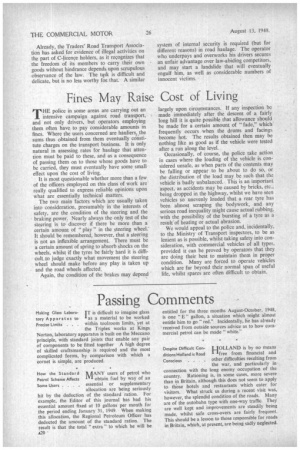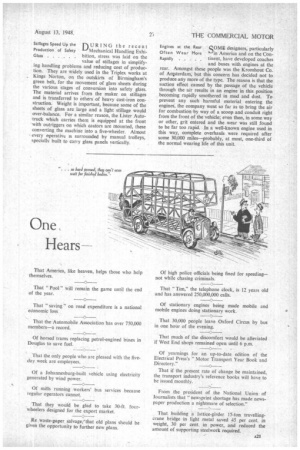Passing Comments
Page 22

Page 23

If you've noticed an error in this article please click here to report it so we can fix it.
Making Glass LaboraIT is difficult to imagine glass tory Apparatus to Las a material to be worked Precise Limits . . . within toolroom limits,-yet at
the Triplex works at Kings Norton, laboratory apparatus is built on the Meccano principle, with standard joints that enable any pair of components to be fitted together A high degree of skilled craftsmanship is required and the most complicated forms, by comparison with which a cornet is simple, are produced.
How the Standard ItilANY users of petrol who Petrol Scheme Affects l" obtain fuel by way of an Some Users . . . essential or supplementary
allocation are being seriously hit by the deduction of the standard ration. For example, the Editor of this journal has had his essential amount fixed at 10 gallons per month for the period ending January 31, 1949. When making this allocation, the Regional Petroleum Officer has deducted the amount of the standard ration. The result is that the total " extra " to which he will be £20
entitled for the three months August-October, 1948, is one "E" gallon, a situation which might almost entitle him to go "red." Incidentally, he has already received from outside sources advice as to how commercial petrol can be made "white."
Despite Difficult ConHOLLAND is by no means ditions Holland is Road free from financial and Conscious other difficulties resulting from
the war, and particularly in connection with the long enemy occupation of the country. Rationing is, in some cases, more severe than in Britain, although this does not seem to apply to those hotels and restaurants which cater for visitors. What struck us during a recent visit was, however, the splendid condition of the roads. Many are of the autobahn type with one-way traffic. They are well kept and improvements are steadily being made, whilst safe cross-overs are fairly frequent. This should be a lesson to those responsible for roads in Britain, which, at present, are being sadly neglected.
Stillages Speed Up the flURING the recent Production of Safety 1-"Mechanical Handling Exhi Glass bition, stress was laid on the
value of stillages in simplifying handling problems and reducing cost of production. They are widely used in the Triplex works at Kings Norton, on the outskirts of Birmingham's green belt, for the movement of glass sheets during the various stages of conversion into safety glass. The material arrives from the maker on stillages and is transferred to others of heavy cast-iron construction. Weight is important, because some of the sheets of glass arc large and a light stillage would over-balance. For a similar reason, the Lister Autotruck which carries them is equipped at the front with outriggers on which castors are mounted, these converting the machine into a five-wheeler. Almost every operative is surrounded by manual trolleys, specially built to carry glass panels vertically.
Engines at the Rear OME designers, particularly Often Wear More "in America and on the Con Rapidly tinent, have developed coaches and buses with engines at the rear. Amongst these people was the Kromhout Co. of Ainsterdam, but this concern has decided not to produce any more of the type. The reason is that the suction effect caused by the passage of the vehicle through the air results in an engine in this position becoming rapidly smothered in mud and dust. To prevent any such harmful material entering the engines, the company went so far as to bring the air for combustion by way of a scoop and conduit right from the front of the vehicle; even then, in some way or other, grit entered and the wear was still found to be far too rapid. in a well-known engine used in this way, complete overhauls were required after some 30,000 miles—probably, at most, one-third of the normal wearing life of this unit.












































































